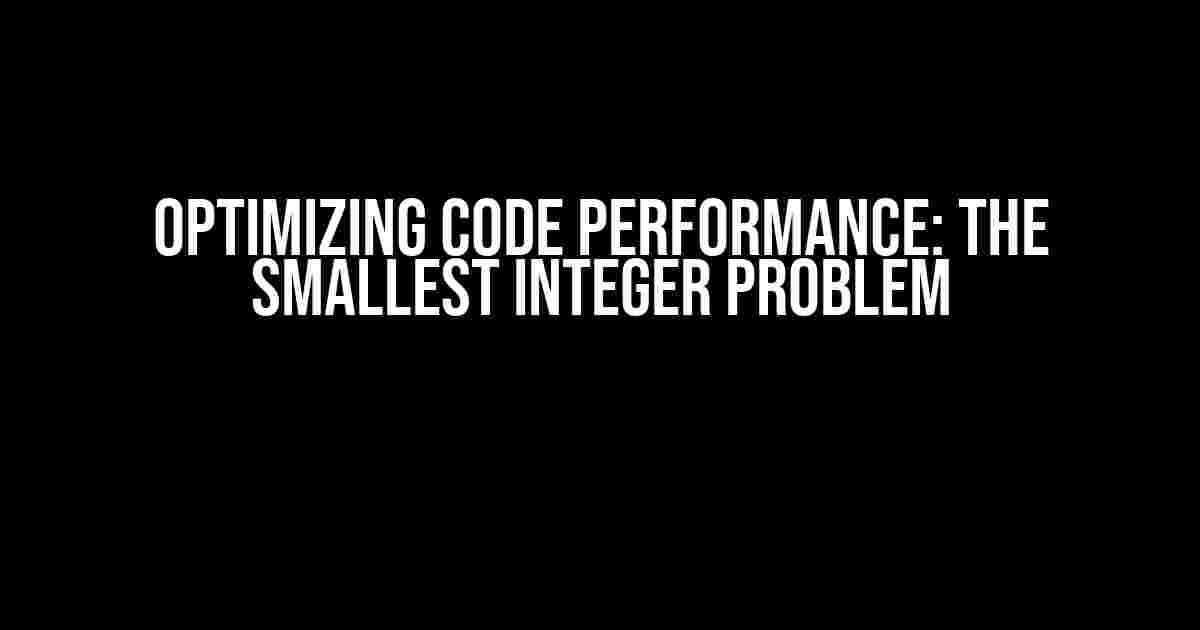Introduction
When it comes to coding, efficiency and performance are crucial aspects to consider. One common problem that programmers face is the “Smallest Integer Problem,” where the goal is to find the smallest integer that is not present in a given array. In this article, we will delve into the world of code optimization and explore the best approaches to solve this problem with maximum performance.
The Problem Statement
Given an array of integers, write a function to find the smallest positive integer that is not present in the array. For example, if the input array is [3, 4, -1, 1], the output should be 2, as it is the smallest positive integer missing from the array.
Approach 1: Brute Force Method
A straightforward approach to solve this problem is to iterate through the array and check for each positive integer if it is present or not. This approach has a time complexity of O(n^2), making it inefficient for large arrays.
def find_smallest_integer(arr):
for i in range(1, len(arr) + 2):
if i not in arr:
return i
Approach 2: Hash Table Method
A more efficient approach is to use a hash table to store the elements of the array and then iterate through the positive integers to find the smallest missing integer. This approach has a time complexity of O(n), making it much faster than the brute force method.
def find_smallest_integer(arr):
hash_table = set(arr)
for i in range(1, len(arr) + 2):
if i not in hash_table:
return i
Approach 3: Sorting Method
Another approach is to sort the array and then iterate through the sorted array to find the smallest missing integer. This approach has a time complexity of O(n log n) due to the sorting operation.
def find_smallest_integer(arr):
arr.sort()
for i in range(1, len(arr) + 2):
if i != arr[i - 1]:
return i
Comparison and Conclusion
The following table compares the performance of the three approaches:
- Brute Force Method: O(n^2)
- Hash Table Method: O(n)
- Sorting Method: O(n log n)
As shown, the Hash Table Method is the most efficient approach to solve the Smallest Integer Problem, with a time complexity of O(n). This approach is particularly useful when dealing with large arrays. By optimizing our code performance, we can reduce the computational time and improve the overall efficiency of our programs.
Best Practices for Code Performance
Here are some best practices to keep in mind to optimize code performance:
- Use hash tables or dictionaries to store and retrieve data efficiently.
- Avoid unnecessary loops and iterations.
- Use sorting and indexing to reduce computational time.
- Optimize algorithms and data structures for the specific problem at hand.
By following these best practices and choosing the most efficient approach, we can write high-performance code that meets the requirements of the problem and reduces computational time.
Frequently Asked Question
Get ready to dive into the world of coding and understand the intricacies of the smallest integer problem code performance!
What is the smallest integer problem in coding?
The smallest integer problem, also known as the smallest multiple problem, is a classic coding challenge where you’re asked to find the smallest positive integer that is divisible by all numbers in a given range. It’s a great way to practice your coding skills and learn optimization techniques!
Why is performance important in the smallest integer problem?
Performance is crucial in the smallest integer problem because the naive approach can lead to exponential time complexity, making it inefficient for large inputs. A well-optimized solution can reduce the computation time significantly, making it essential to focus on performance optimization techniques like dynamic programming and memoization!
How can I improve the performance of my smallest integer problem code?
To boost the performance of your code, try using techniques like caching, lazy evaluation, and recursive function memoization. You can also leverage mathematical properties like the least common multiple (LCM) to reduce the computation time. Don’t forget to profile your code and identify performance bottlenecks to optimize further!
Can I use parallel processing to speed up my smallest integer problem code?
Yes, you can definitely use parallel processing to speed up your code! Since the smallest integer problem involves independent calculations, you can split the work among multiple threads or processes. This can lead to significant performance gains, especially for large inputs. Just be mindful of synchronization and communication overheads to avoid Performance bottlenecks!
What are some common pitfalls to avoid when optimizing the smallest integer problem code?
When optimizing your code, watch out for common pitfalls like premature optimization, over-optimization, and neglecting edge cases. Make sure to test your code with diverse inputs and validate its correctness before diving into performance optimization. Also, don’t forget to measure and profile your code to identify real bottlenecks and avoid optimizing the wrong parts!

